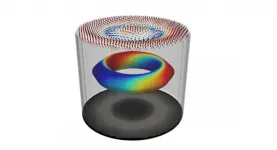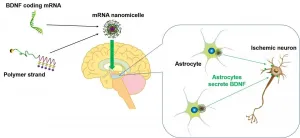(Press-News.org) The millions of people who have chronic sinusitis deal not only with stuffy noses and headaches, they also commonly struggle to focus, and experience depression and other symptoms that implicate the brain's involvement in their illness.
New research links sinus inflammation with alterations in brain activity, specifically with the neural networks that modulate cognition, introspection and response to external stimuli.
The paper was published today in JAMA Otolaryngology-Head & Neck Surgery.
"This is the first study that links chronic sinus inflammation with a neurobiological change," said lead author Dr. Aria Jafari, a surgeon and assistant professor of Otolaryngology-Head & Neck Surgery at the University of Washington School of Medicine.
"We know from previous studies that patients who have sinusitis often decide to seek medical care not because they have a runny nose and sinus pressure, but because the disease is affecting how they interact with the world: They can't be productive, thinking is difficult, sleep is lousy. It broadly impacts their quality of life. Now we have a prospective mechanism for what we observe clinically."
Chronic rhinosinusitis affects about 11% of U.S. adults, according to the Centers for Disease Control and Prevention. The condition can necessitate treatment over a span of years, typically involving antibiotics. Repeated cycles of inflammation and repair thicken sinus tissues, much like calloused skin. Surgery may resolve the issue, but symptoms also can recur.
The researchers identified a study cohort from the Human Connectome Project, an open-access, brain-focused dataset of 1,206 healthy adults ages 22-35. Data included radiology image scans and cognitive/behavioral measurements.
The scans enabled them to identify 22 people with moderate or severe sinus inflammation as well as an age- and gender-matched control group of 22 with no sinus inflammation. Functional MRI (fMRI) scans, which detect cerebral blood flow and neuronal activity, showed these distinguishing features in the study subjects:
decreased functional connectivity in the frontoparietal network, a regional hub for executive function, maintaining attention and problem-solving;
increased functional connectivity to two nodes in the default-mode network, which influences self-reference and is active during wakeful rest and mind-wandering;
decreased functional connectivity in the salience network, which is involved in detecting and integrating external stimuli, communication and social behavior.
The magnitude of brain-activity differences seen in the study group paralleled the severity of sinus inflammation among the subjects, Jafari said.
Despite the brain-activity changes, however, no significant deficit was seen in the behavioral and cognitive testing of study-group participants, said Dr. Kristina Simonyan, a study co-author. She is an associate professor of otolaryngology-head & neck surgery at Harvard Medical School and director of laryngology research at Massachusetts Eye and Ear.
"The participants with moderate and severe sinus inflammation were young individuals who did not show clinically significant signs of cognitive impairment. However, their brain scans told us a different story: The subjective feelings of attention decline, difficulties to focus or sleep disturbances that a person with sinus inflammation experiences might be associated with subtle changes in how brain regions controlling these functions communicate with one another," said Simonyan.
It is plausible, she added, that these changes may cause more clinically meaningful symptoms if chronic sinusitis is left untreated. "It is also possible that we might have detected the early markers of a cognitive decline where sinus inflammation acts as a predisposing trigger or predictive factor," Simonyan said.
Jafari sees the study findings as a launch pad to explore new therapies for the disease.
"The next step would be to study people who have been clinically diagnosed with chronic sinusitis. It might involve scanning patients' brains, then providing typical treatment for sinus disease with medication or surgery, and then scanning again afterward to see if their brain activity had changed. Or we could look for inflammatory molecules or markers in patients' bloodstreams."
In the bigger picture, he said, the study may help ear-nose-throat specialists be mindful of the less-evident distress that many patients experience with chronic sinusitis.
"Our care should not be limited to relieving the most overt physical symptoms, but the whole burden of patients' disease."
INFORMATION:
Study funding was provided by the National Institute on Deafness and Other Communication Disorders (R01DC011805), part of the National Institutes of Health (NIH). Data were provided in part by the Human Connectome Project, which is funded by 16 NIH institutes and centers (1U54MH091657).
Expressive language sampling (ELS) is a useful tool for measuring communication development in youth with Down syndrome, a END ...
Cyberbullying already accounts for one in four cases of bullying and, according to the latest UNICEF report issued on the occasion of 'Safer Internet Day', it affects at least two students per class in Spanish schools.
In this regard, the Laboratory of Studies on Coexistence and Violence Prevention at the University of Cordoba, under the direction of professors Rosario Ortega-Ruiz and Eva M. Romera, has just published a study examining family communication and its impact on cyber-gossip and the excessive use of social media-two of the main factors with the greatest influence on cyber-bullying. Their results point in the same direction: an atmosphere of trust in the family is an antidote to this type of behaviour, reducing the risk of schoolchildren engaging inproblematic ...
Calibration and validation (CAL/VAL) is a key technology for quantitative application of space-borne remote sensing data. However, the complex space environment can cause many uncertainties and degrade the calibration accuracy. In-flight calibration is always needed. The thermal emission of the Moon is stable over hundreds of years because there is no atmosphere and no significant physical or chemical change on its surface. The deep space view of the Microwave Humidity Sounder onboard NOAA-18 has viewed the Moon many times every year. Under solar illumination, the lunar surface shows stable and periodical variation in microwave brightness temperature (TB). The Moon is a potential calibration source for thermal calibration
The ...
A decade ago, the discovery of quasiparticles called magnetic skyrmions provided important new clues into how microscopic spin textures will enable spintronics, a new class of electronics that use the orientation of an electron's spin rather than its charge to encode data.
But although scientists have made big advances in this very young field, they still don't fully understand how to design spintronics materials that would allow for ultrasmall, ultrafast, low-power devices. Skyrmions may seem promising, but scientists have long treated skyrmions as merely 2D objects. Recent studies, however, have suggested that 2D skyrmions could actually be the genesis of a 3D spin pattern called hopfions. ...
In all adult vertebrates, neural stem cells can be recruited to produce new neurons in the brain. However, little is known about these so-called "activation" processes.
Scientists at the Institut Pasteur, CNRS, and Tel Aviv University working in collaboration with the École Polytechnique and INRAE have successfully performed 3D visualization and spatial and temporal distribution analysis of neural stem cell activation in the adult brain of a zebrafish vertebrate model.
Their findings demonstrate for the first time that activation events for these cells are coordinated ...
Powerful algorithms used by Netflix, Amazon and Facebook can 'predict' the biological language of cancer and neurodegenerative diseases like Alzheimer's, scientists have found.
Big data produced during decades of research was fed into a computer language model to see if artificial intelligence can make more advanced discoveries than humans.
Academics based at St John's College, University of Cambridge, found the machine-learning technology could decipher the 'biological language' of cancer, Alzheimer's, and other neurodegenerative diseases.
Their ground-breaking study has been published in the scientific journal PNAS today (April 8 2021) and could be used in the future to 'correct the grammatical mistakes inside cells that cause disease'.
Professor Tuomas Knowles, lead ...
The prevalence of SARS-CoV-2 infections in preschool and school children is an important benchmark for deciding whether to open kindergartens and schools. The screening study "Fr1da" led by Anette-Gabriele Ziegler tests children in Bavaria for an early stage of type 1 diabetes. These tests include the collection of blood samples. In response to the COVID-19 pandemic, the researchers had decided to use the valuable study infrastructure of the Fr1da study to detect SARS-CoV-2 infections, too. For this, they developed a SARS-CoV-2 antibody test with particularly high accuracy. During the first ...
The rainfall over the Yangtze River Valley (YRV) in June 2020 broke the record since 1979 (Figure 1). As of June 28, the People's Daily Online reported that there were more than 12 million people affected by flood disasters related to this torrential rain, with deaths or disappearances of 78 persons and a direct economic loss of more than 25 billion CNY. Recently, scientists from South China Sea Institute of Oceanology (SCSIO), Chinese Academy of Sciences revealed the cause of the record-breaking rainfall over the YRV.
According to their study published in Science China Earth Sciences on March 19, 2021, all three oceans of the Pacific, Indian and Atlantic Oceans ...
Researchers from Tokyo Medical and Dental University (TMDU) demonstrate an mRNA delivery system that effectively produces BDNF protein in rat brain to protect neurons from ischemia
Tokyo - A lack of oxygen to brain tissue--known as ischemia--leads to the death of neurons, which results in stroke. Despite considerable research, there are currently no treatments that successfully prevent neuronal death. Now, Tokyo Medical and Dental University (TMDU) researchers have reported a way of delivering mRNA to produce a therapeutic protein that protects neurons. Their findings, demonstrated in rats, ...
Cycling at moderate intensity during dialysis could drastically improve the heart health of patients with kidney failure and result in significant savings for the NHS, according to new research by the University of Leicester supported by the charity Kidney Research UK and National Institute for Health Research (NIHR) Leicester Biomedical Research Centre.
Patients in the CYCLE-HD study were offered 30 minutes of moderate intensity exercise on a specially adapted bicycle during their regular dialysis sessions. Dialysis can lead to long-term scarring of the heart, which can accumulate over time and lead to heart failure. The study set out to examine ...





